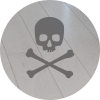Schools, homes, apartment complexes, and businesses are all susceptible to mold and mildew growth. Mold grows off of water and survives on food sources (leaves, wood, paper, and dirt), oxygen, and temperatures between 40° and 100° Fahrenheit. So essentially, mold can be found anywhere. In your home, outside, and in almost any environment. Humidity and moisture in the air will invite mold into your home. And if mold spores land on a moist spot in your home, molds will begin growing and put your health at risk.
Health Risks
 You might find you’re having throat irritation, difficulty breathing, nasal and sinus congestion, skin rashes, and eye irritations. Mold isn’t always easy to spot, so if you notice you’re developing any of these conditions, or they have gotten worse, mold could be at fault.
You might find you’re having throat irritation, difficulty breathing, nasal and sinus congestion, skin rashes, and eye irritations. Mold isn’t always easy to spot, so if you notice you’re developing any of these conditions, or they have gotten worse, mold could be at fault.
Identifying the Source
 Any water damage to your home will invite mold to take over. Many think of mold damage occurring in the basement and kitchen, but this fungus is capable of growing in any room of the house. A flood, sitting water, a leaky roof, leaky pipes, and humidity can all attract mold growth. Detecting mold is tricky, but the EPA has provided an interactive mold house tour to help you identify any mold issues and the precautions that can be taken to avoid serious home damage.
Any water damage to your home will invite mold to take over. Many think of mold damage occurring in the basement and kitchen, but this fungus is capable of growing in any room of the house. A flood, sitting water, a leaky roof, leaky pipes, and humidity can all attract mold growth. Detecting mold is tricky, but the EPA has provided an interactive mold house tour to help you identify any mold issues and the precautions that can be taken to avoid serious home damage.
- Keeping your gutters clean and free of sitting water and debris will decrease mold growth.
- Continual roof maintenance and inspection will also save you the hassle of dealing with a leaky roof and the potential mold damage done to your attic, walls, and ceilings.
- If it isn’t humid outside, open the windows to let in fresh air. When humidity is a problem outside, and your indoor levels are higher than 60%, look into purchasing a dehumidifier to help keep the moister levels down.
- The ideal moisture range is anywhere from 30 to 50%.
- Your oven’s exhaust hood and your clothes dryer vents should be vented outside since both appliances create a lot of humidity.
- Another simple precaution is directing your drains away from the house. Having your gutter drains at least five feet away from your home’s foundation will avoid the chance of water leaking into your basement.
- Properly caulking your windows and around water fixtures will reduce the risk of leaking water into your home.
Mold Clean Up
 If the mold area is ten feet or less, it is probably a small enough area that you don’t need to hire someone. When you’re cleaning up mold, be sure to wear gloves, protective eyewear, and old clothes. Mix a gallon of water with one cup of bleach to disinfect the area. You will typically not need to get rid of plastic or glass as mold cannot grow in these materials, however, any wood or paper items will most likely need to be discarded. So if you’ve found mold growing on your basement walls, there is a high chance that the entire wall will need to be replaced. Mold damage is a natural problem that occurs in every household. Some cases are far worse than others, so be sure to contact a mold specialist if additional help is needed. For more tips on mold in your home, click here.
If the mold area is ten feet or less, it is probably a small enough area that you don’t need to hire someone. When you’re cleaning up mold, be sure to wear gloves, protective eyewear, and old clothes. Mix a gallon of water with one cup of bleach to disinfect the area. You will typically not need to get rid of plastic or glass as mold cannot grow in these materials, however, any wood or paper items will most likely need to be discarded. So if you’ve found mold growing on your basement walls, there is a high chance that the entire wall will need to be replaced. Mold damage is a natural problem that occurs in every household. Some cases are far worse than others, so be sure to contact a mold specialist if additional help is needed. For more tips on mold in your home, click here.